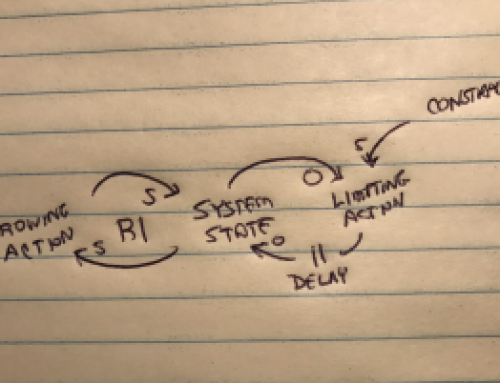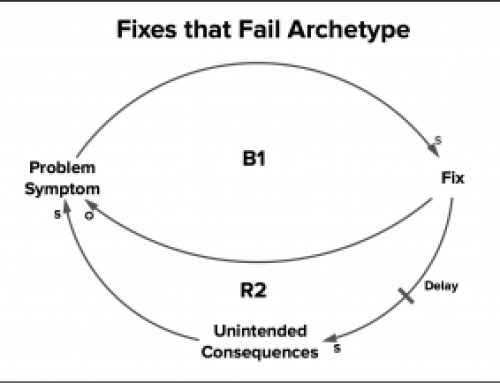There are multiple ways that one can think about a business organization and the way that organization evolves over time. As the discipline of organization development has evolved over the years there have been various approaches to this thinking. Organizations do evolve, just as living organisms evolve over time and, in fact, the organizations follow a predictable and repetitive pattern in terms of how they evolve, specific challenges that arise, and the specific and unavoidable end that is ultimately unavoidable. The purpose of this article is to examine the model of corporate life cycle evolution and introduce you to some of the repetitive patterns and forces at work within your own business at it evolves. With that said, I should also make clear that you as a leader, and as part of a leadership team, have the power to make healthy transitions from one stage to another, return to an earlier stage to reinvigorate your business, and to proactively get ahead of some of the predictable challenges you will encounter in your own business life cycle. This article and subsequent articles on this topic will outline a roadmap for understanding the model and taking appropriate action based on your own organization’s current life cycle stage.
Understanding the Life Cycles
I introduced you to the corporate life cycle model that appears here in my last post.
This model was first developed by L.E. Greiner and then built upon by Ichak Adizes who fleshed out more of the concepts of the management forces that drive each stage of the life cycle. You can see the model describes the various stage of an organization’s evolution from Courtship (the organization is yet unborn) through Death (bankruptcy or dissolution). Let’s examine each of these ten stages and the organization’s characteristics at each stage of the cycle.
Courtship (Entrepreneurs)
Courtship is the stage just before the birth of an organization. Someone or groups of people share a vision and passion for starting something new. This may be born from identifying some significant unmet need in a market, from having created something unique that has yet to be introduced and can create demand in the market by virtue of a new value, from seeing a market segment that is underserved or served poorly, or other reason. Whatever the reason, the founder or founding group is working to build commitment, generate cash for the initial launch. The forces at work are extremely entrepreneurial and ideas, both realistic and unrealistic are expected at this stage.
Infancy (Entrepreneurs, needing Producers)
An organization is born and exists in a stage of infancy. During this stage, the organization is frequently driven by sales. After all, the organization needs to generate cash. At the same time, the organization may still have great need to continue to invest in the creation and refinement of product or services and find there is an ongoing battle between the need to generate cash and the need to invest. If undercapitalized, the organization may take sales at any price, or any cost, depending on how you look at it. The organization may also find themselves stretched by over commitment and will definitely begin considering what resources are needed to fulfill those commitments. The entrepreneurial spirit and thinking must embrace more of a “production” element either by tapping into their own thinking and talents or by adding others to the mix that “hit the ground” selling, producing — “doing.”
Go-Go (Entrepreneurs, Producers)
The Go-Go stage is exciting, energetic, unbridled and probably is best described as the “wild wild west” where everyone is busy, things are moving quickly, there is so much to get done, and where priorities can get lost very quickly. Producers are on board selling, producing, and doing, and opportunities seem endless. Opportunities drive everything and there is likely an accepted theory between everyone involved that “more” is better. There is certainly growth, and this is vital to the future of the organization, but there are also needs arising relating to structure, clear direction, systems, concrete processes, and priority evaluation and execution. There is a growing need for some administrator skills and founders face an important time of transition in relationship to growth. Does the founder have the skills to provide clear administration or does the founder start hiring more professional management skills? Even more pronounced is the dilemma that many founders face in terms of actually stepping aside, selling, or abdicating control completely to others. The loss of the entrepreneurial force is at risk in this circumstance.
Adolescence (entrepreneurs, Producers, Administrators
The next transition of an organization is into a stage of adolescence. Just saying that word probably conjures up many images amongst those of you that are or have been parents of adolescent youth! This is the point where Administrators start rising in terms of power because honestly, order is much needed amidst the chaos generated by the Go-Go stage of the life cycle. Growth is still occurring but with the rise of new administrative policies, there are also expected problems that arise and potential risks of damaging the growth pattern if those problems are not clearly addressed. There is resistance to new processes and procedures due to the euphoric experience of the wild west. The founder (any of those entrepreneurs from the start) may experience difficulty in delegating and might experience a serious fear about the loss of control. As structure is put into place, there can be confusion and also mismatches in terms of talents (producers that are promoted as managers that lack the skills). The risk is what is called “premature aging” within the life cycle model. Premature aging can occur if the administration squeezed off the entrepreneurs and producers through over-controlling every situation. Key decisions must be made to stay on track with the mission, apply the right controls, and especially regarding the emerging leadership team.
PRIME (Entrepreneurs, Producers, Administrators, Integrators)
PRIME is the desired state of an organization and is a sign that the organization is evolving and maturing naturally. Entrepreneurs, Producers, and Administrators are in synch with processes and controls that allow continued growth while managing that growth. Integrators now rise within the organization as well. Integrators see the value of long-term commitment to systems and interdependent relationships of departments and processes and thus, integrate efforts across all fronts. During this stage, new products or new organizations spin off and start anew at infancy as the company reproduces as needed to fill market needs, capitalizing on new opportunities. Still, leadership must stay vigil at this stage to avoid complacency (counting the money). If decisions are only made based on the value of decisions made in the past and vision is not maintained for future opportunity, then the overall vision will lack clarity for the future. This is also the stage in which it is easy to fail to plan for succession in the event of losing key personnel, or failure to keep developing talent within the organization. This is the best of stages, but a stage where investments must be made in the future. Too many businesses get to this stage and get fat on success.
Late Prime (entrepreneurs, Producers, Administrators, Integrators)
Late Prime is a stage of stability and a very subtle change from the PRIME stage. In Late Prime, the wheels keep turning and the business seems very stable, but it biomes obvious that innovation begins to fade as many of the entrepreneurs start feeling too controlled, grow complacent, or leave because of their well-known success and demand for their talent. Producers and Administrators keep driving forward by doing and managing and finance starts becoming a key measurement that is front and center. The real trap of this stage is that many simply do not notice that the organization is starting to age and grow complacent as a whole. The focus is return to investment, financial performance, and maintaining the status quo.
Aristocracy (entrepreneurs, producers, Administrators, integrators)
Aging gains full steam in the stage of Aristocracy. These are the days to enjoy the fruits of all that labor. Many organizations build out offices, focus on and protect their image, and overall maintain the status of their success in various forms. Rather than innovating and creating new organic infants in terms of products or organizations, it is more likely that an Aristocratic company will “acquire” new businesses in order to grow the balance sheet. Debt may become an issue due to overestimation of the value of such acquisitions. The culture within the organization starts to echo the “don’t make waves” approach to surviving and fears start to arise within the organization about the future.
Recrimination (Administrators, integrators)
By the time the stage of Recrimination occurs, customers are primarily considered a nuisance to deal with and many within the organization just wish they would pay their bills quietly and not complain. Within the organization, administrators are hard at work trying to keep things together and some integrators are still around but they are frustrated with the lack of innovation and the value of their jobs are less apparent as the organization must continue to make cuts to survive. There is frequent finger pointing and likely a revolving door in leadership as investors try one leader after another to manage the bleeding and find some strategy that will work. Without intervention that will re-invest in entrepreneurial efforts and producing based on new opportunities, the company will continue to age rapidly.
Bureaucracy (Administrators)
At the Bureaucracy stage, the primary force is that of administration. This stage is simply about survival. There are policies for everything in an attempt to control costs. The culture is all about keeping your head down and finding something to produce and add to the pie or risk losing your job. By this point, the best talent has already jumped ship or about to jump ship and those left are those that would say they are looking for other opportunities and just staying for now to keep a paycheck. Divestitures may occur for specific divisions or product lines ended, with leadership focusing on the high-margin aspects of the business. Last-ditch efforts are made to find new ways to sell and there are frequent stories of the loss of customers or less commitment from customers as they find new sources that are more responsive to their needs or more innovative with their offerings.
Death
The organization is dead.
Leadership Forces at Work in the Life Cycle
Throughout the description of the life cycles above, I used the terms “administrators,” “producers,” “entrepreneurs,” and integrators.” Think of these as the driving forces at work within the organization based on the focus of leadership and leadership decisions. I first wrote about these forces in an earlier post called “Organization Effectiveness Quadrants – Where Does your Organization Fit?” and you may want to review that article as you continue reading. As an introduction, here are the basic definitions of those four forces:
- (P)roducer – focused on the activity of attaining short term or immediate results.
- (A)dministrator – focused on the activity of minimizing waste in ongoing activities
- (E)ntrepreneur – focused on the activity of seeking out and recognizing new opportunities or new orientations to the environment
- (I)ntegrator – focused on the activity of coordinating shared resources and identifying and creating shared systems
In my next post, I will take a closer look at these forces that work together at each stage of the lifecycle and examine how they relate to the concepts of effectiveness and efficiency within an organization. These four forces and their relationship to effectiveness and efficiency are at the heart of the life cycle model and the decisions you face in transitioning from stage to stage to ensure that your organization gets to and stays at PRIME.
From Entrepreneur to CEO offers a complete framework and set of coaching and consulting services to get you to PRIME and keep you operating at PRIME. We call this Lead-to-PRIME and you can learn more HERE.


